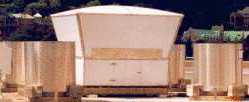Radio acoustic sounding system
|
B. Geerts |
9/'98 |
|
A radio acoustic sounding system (RASS) consists of one or more vertically pointed loudspeakers, surrounded by focusing dishes and an antenna that receives the return signal from above. It is a remote sensing technique for the measurement of virtual temperature profiles. The speed of sound in air (ca, in m/s) is given by: |
|

where Tv is the virtual temperature in Kelvin. The virtual temperature, by definition, is: Tv = T (1+0.61*r), where r is the mixing ratio of water vapour in the air (in kg/kg), and T the air temperature (K). Because r is on the order of 10-3, and at most 10-2 kg/kg, Tv is at most 3K higher than T. Therefore, if a reasonable estimate of the humidity profile is available, RASS provides a continues measure of the temperature profile.
The propagation of sound implies compression and expansion of the air. The burst of sound emitted by the RASS propagates upward in the troposphere, and the associated air displacement is tracked by a Doppler radar (usually a 915 MHz wind profiler). Obviously the acoustic wavelength must be half the radar wavelength (Bragg condition). Therefore, the RASS temperature profile is deduced from the radar measurement of the speed of sound.
Limitations of the RASS include:
- sound absorption by atmosphere;
- horizontal translation of sound waves by the wind;
- distortion of sound waves by atmospheric turbulence.
Typically, RASS-derived temperature profiles reach up to the maximum height of the associated wind profiler, or less. For a 915 MHz system, that is 1-3 km above ground level (1). The
National Oceanographic and Atmospheric Administration (NOAA) operates a network of 400 MHz profiler/ RASS systems in the US.
Reference
(1) Angevine, W.M., A.W. Grimsdell, L.M. Hartten and A.C. Delany 1998. The Flatland boundary layer experiments. Bull. Amer. Meteor. Soc., 79, 419-31.
